Mecklenburg County, North Carolina
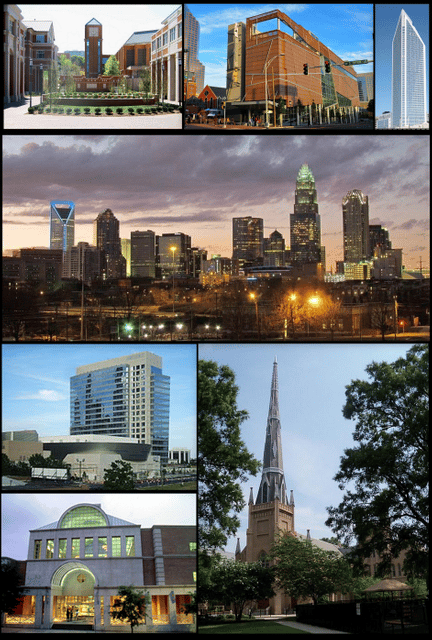
Mecklenburg County, North Carolina

Mecklenburg County | |
|---|---|
U.S. county | |
 Location within the U.S. state of North Carolina | |
 North Carolina's location within the U.S. | |
| Coordinates:35°15′N 80°50′W [41] | |
| Country | |
| State | |
| Founded | November 6, 1762 |
| Named for | Charlotte of Mecklenburg-Strelitz |
| Seat | Charlotte |
| Largest city | Charlotte |
| Area | |
| • Total | 546 sq mi (1,410 km2) |
| • Land | 524 sq mi (1,360 km2) |
| • Water | 22 sq mi (60 km2) 4.0%% |
| Population | |
| • Estimate (2018) | 1,093,901 |
| • Density | 2,013.0/sq mi (777.2/km2) |
| Demonym(s) | Mecklenburger |
| Time zone | UTC−5 (Eastern) |
| • Summer (DST) | UTC−4 (EDT) |
| Congressional districts | 9th, 12th |
| Website | www.mecknc.gov [42] |
Mecklenburg County is a county located in the southwestern region of the state of North Carolina, in the United States. As of the 2010 census, the population was 919,618. It increased to 1,034,070 as of the 2015 estimate, making it the most populous county in North Carolina and the first county in the Carolinas to surpass 1 million in population.[1] Its county seat and largest city is Charlotte.[2]
Like its seat, the county is named after Charlotte of Mecklenburg-Strelitz, queen of the United Kingdom, whose name is derived from the region of Mecklenburg in Germany, itself deriving its name from Mecklenburg Castle (Mecklenburg meaning "large castle" in Low German) in the village of Dorf Mecklenburg.
Mecklenburg County | |
|---|---|
U.S. county | |
 Location within the U.S. state of North Carolina | |
 North Carolina's location within the U.S. | |
| Coordinates:35°15′N 80°50′W [41] | |
| Country | |
| State | |
| Founded | November 6, 1762 |
| Named for | Charlotte of Mecklenburg-Strelitz |
| Seat | Charlotte |
| Largest city | Charlotte |
| Area | |
| • Total | 546 sq mi (1,410 km2) |
| • Land | 524 sq mi (1,360 km2) |
| • Water | 22 sq mi (60 km2) 4.0%% |
| Population | |
| • Estimate (2018) | 1,093,901 |
| • Density | 2,013.0/sq mi (777.2/km2) |
| Demonym(s) | Mecklenburger |
| Time zone | UTC−5 (Eastern) |
| • Summer (DST) | UTC−4 (EDT) |
| Congressional districts | 9th, 12th |
| Website | www.mecknc.gov [42] |
History
Mecklenburg County was formed in 1762 from the western part of Anson County, both in the Piedmont section of the state. It was named in commemoration of the marriage of King George III to Charlotte of Mecklenburg-Strelitz,[4] for whom the county seat Charlotte is named. Due to unsure boundaries, a large part of south and western Mecklenburg County extended into areas that would later form part of the state of South Carolina. In 1768, most of this area (the part of Mecklenburg County west of the Catawba River) was designated Tryon County, North Carolina.
Determining the final boundaries of these "western" areas between North and South Carolina was a decades-long process. As population increased in the area following the American Revolutionary War, in 1792 the northeastern part of Mecklenburg County was taken by the North Carolina legislature for Cabarrus County. Finally, in 1842 the southeastern part of Mecklenburg County was combined with the western part of Anson County to become Union County.
The Mecklenburg Declaration of Independence was allegedly signed on May 20, 1775; if the document is genuine, Mecklenburg County was the first part of the Thirteen Colonies to declare independence from Great Britain.[5] The "Mecklenburg Resolves" were adopted on May 31, 1775. Mecklenburg continues to celebrate the Meck Dec each year in May.[6] The date of the Mecklenburg Declaration is also listed on the flag of North Carolina, represented by the date of May 20, 1775 as one of two dates on the flag of the old North State.
Geography
According to the U.S. Census Bureau, the county has a total area of 546 square miles (1,410 km2), of which 524 square miles (1,360 km2) is land and 22 square miles (57 km2) (4.0%) is water.[7]
Adjacent counties
Iredell County - north
Cabarrus County - northeast
Union County - southeast
Lancaster County, South Carolina - south
York County, South Carolina - southwest
Gaston County - west
Catawba County - northwest
Lincoln County - northwest
Demographics
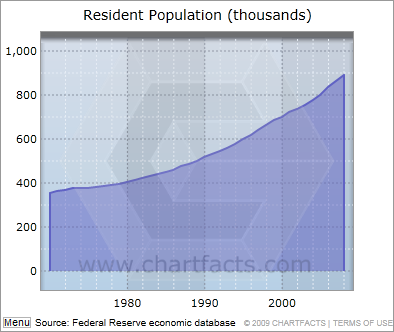
Population grew 2.5% per year from 1970 to 2008
| Historical population | |||
|---|---|---|---|
| Census | Pop. | %± | |
| 1790 | 11,395 | — | |
| 1800 | 10,439 | −8.4% | |
| 1810 | 14,272 | 36.7% | |
| 1820 | 16,895 | 18.4% | |
| 1830 | 20,073 | 18.8% | |
| 1840 | 18,273 | −9.0% | |
| 1850 | 13,914 | −23.9% | |
| 1860 | 17,374 | 24.9% | |
| 1870 | 24,299 | 39.9% | |
| 1880 | 34,175 | 40.6% | |
| 1890 | 42,673 | 24.9% | |
| 1900 | 55,268 | 29.5% | |
| 1910 | 67,031 | 21.3% | |
| 1920 | 80,695 | 20.4% | |
| 1930 | 127,971 | 58.6% | |
| 1940 | 151,826 | 18.6% | |
| 1950 | 197,052 | 29.8% | |
| 1960 | 272,111 | 38.1% | |
| 1970 | 354,656 | 30.3% | |
| 1980 | 404,270 | 14.0% | |
| 1990 | 511,433 | 26.5% | |
| 2000 | 695,454 | 36.0% | |
| 2010 | 919,628 | 32.2% | |
| Est. 2018 | 1,093,901 | [8] | 19.0% |
| U.S. Decennial Census[9] 1790-1960[10] 1900-1990[11] 1990-2000[12] 2010-2013[1] | |||
As of the census[13] of 2000, there were 695,454 people, 273,416 households, and 174,986 families residing in the county. The population density was 1,322 people per square mile (510/km²). There were 292,780 housing units at an average density of 556 per square mile (215/km²). The racial makeup of the county was 64.02% White, 27.87% Black or African American, 0.35% Native American, 3.15% Asian, 0.05% Pacific Islander, 3.01% from other races, and 1.55% from two or more races. 6.45% of the population were Hispanic or Latino of any race.
There were 273,416 households out of which 32.10% had children under the age of 18 living with them, 47.70% were married couples living together, 12.40% had a female householder with no husband present, and 36.00% were non-families. 27.60% of all households were made up of individuals and 5.90% had someone living alone who was 65 years of age or older. The average household size was 2.49 and the average family size was 3.06.
In the county, the population was spread out with 25.10% under the age of 18, 9.70% from 18 to 24, 36.40% from 25 to 44, 20.30% from 45 to 64, and 8.60% who were 65 years of age or older. The median age was 33 years. For every 100 females there were 96.50 males. For every 100 females age 18 and over, there were 93.60 males.
The median income for a household in the county was $50,579, and the median income for a family was $60,608. Males had a median income of $40,934 versus $30,100 for females. The per capita income for the county was $27,352. About 6.60% of families and 9.20% of the population were below the poverty line, including 11.50% of those under age 18 and 9.30% of those age 65 or over.
Mecklenburg County Government
Mecklenburg County is a member of the regional Centralina Council of Governments.[14]
The County is governed by the Mecklenburg Board of County Commissioners (BOCC). The BOCC is a nine-member board made up of representatives from each of the six county districts and three at-large representatives elected by the entire county. This electoral structure favors candidates in the at-large positions who will be elected by the majority population of the county. Each District has a population of approximately 165,000 individuals. All seats are partisan and are for 2-year terms (elections occur in even years). The current chairman of the Mecklenburg BOCC is George Dunlap (D, District 3). The Current Vice-Chair is Elaine Powell (D, District 1).
Members of the Mecklenburg County Commission are required by North Carolina State law to choose a Chair and Vice-Chair once a year (at the first meeting of December). Historically, the individual elected was the 'top-vote-getter' which was one of three (3) at-large members. In 2014 this unofficial rule was changed by the Board to allow any member to serve as Chair or Vice-chair as long as they received support from 4 members plus their own vote.
The nine members of the Board of County Commissioners are:[15]
George Dunlap (D, District 3, Chairman)
Elaine Powell (D, District 1, Vice Chairman)
Pat Cotham (D, At-Large)
Trevor Fuller (D, At-Large)
Ella Scarborough (D, At-Large)
Vilma Leake (D, District 2)
Mark Jerrell (D, District 4)
Susan B. Harden (D, District 5)
Susan Rodriguez-McDowell (D, District 6)
Law, government and politics
Prior to 1928, Mecklenburg County was strongly Democratic similar to most counties in the Solid South. 1928 marked the start of a long stretch where the county was a national bellwether in most elections up through 2000, only voting against the national winner in 1960 & 1992. From 2004 on, the county has returned to being solidly Democratic as a diverse urban county, with John Kerry's narrow win in 2004 being a prelude to Barack Obama & Hillary Clinton's landslide wins in the county in the following elections.
| Year | Republican | Democratic | Third parties |
|---|---|---|---|
| 2016 | 32.9% 155,518 | 62.3% 294,562 | 4.8% 22,777 |
| 2012 | 38.2% 171,668 | 60.7% 272,262 | 1.1% 4,970 |
| 2008 | 37.5% 153,848 | 61.8% 253,958 | 0.7% 3,011 |
| 2004 | 48.0% 155,084 | 51.6% 166,828 | 0.4% 1,190 |
| 2000 | 51.0% 134,068 | 48.3% 126,911 | 0.8% 2,057 |
| 1996 | 45.9% 97,719 | 48.6% 103,429 | 5.5% 11,697 |
| 1992 | 43.6% 99,496 | 42.5% 97,065 | 13.9% 31,814 |
| 1988 | 59.4% 106,236 | 40.2% 71,907 | 0.4% 653 |
| 1984 | 62.7% 106,754 | 37.1% 63,190 | 0.2% 393 |
| 1980 | 47.8% 68,384 | 46.8% 66,995 | 5.4% 7,679 |
| 1976 | 49.2% 61,715 | 50.4% 63,198 | 0.4% 486 |
| 1972 | 68.5% 77,546 | 29.8% 33,730 | 1.7% 1,900 |
| 1968 | 52.4% 56,325 | 28.9% 31,102 | 18.7% 20,070 |
| 1964 | 48.4% 46,589 | 51.6% 49,582 | |
| 1960 | 55.1% 48,250 | 44.9% 39,362 | |
| 1956 | 62.0% 44,469 | 38.0% 27,227 | |
| 1952 | 57.3% 44,334 | 42.7% 33,044 | |
| 1948 | 34.7% 11,518 | 43.3% 14,353 | 22.0% 7,314 |
| 1944 | 26.7% 9,434 | 73.3% 25,950 | |
| 1940 | 19.6% 7,013 | 80.4% 28,768 | |
| 1936 | 15.3% 4,709 | 84.8% 26,169 | |
| 1932 | 21.3% 4,973 | 77.9% 18,167 | 0.8% 181 |
| 1928 | 55.4% 12,041 | 44.6% 9,690 | |
| 1924 | 22.5% 2,572 | 73.7% 8,443 | 3.8% 437 |
| 1920 | 23.2% 3,421 | 76.8% 11,313 | |
| 1916 | 21.8% 1,257 | 78.1% 4,508 | 0.1% 6 |
| 1912 | 5.9% 284 | 82.3% 3,967 | 11.8% 571 |
Charlotte-Mecklenburg Schools (CMS)
The second largest school system in North Carolina behind Wake County Public Schools. The current Chairman of the Charlotte-Mecklenburg School board is Mary T. McCray (At-Large). The Vice Chair is Ericka Ellis-Stewart (At-Large). The members of the Board of Education [43] are:
Mary T. McCray (At-Large - Chairman)
Elyse C. Dashew (At-Large - Vice Chair)
Ericka Ellis-Stewart (At-Large)
Rhonda Lennon (District 1)
Thelma Byers-Bailey (District 2)
Ruby M. Jones(District 3)
Tom Tate (District 4)
Eric C. Davis (District 5)
Paul Bailey (District 6)
The Charlotte-Mecklenburg School board is non-partisan, and staggered elections are held every two years (in odd years).
MEDIC
The residents of Mecklenburg County are provided emergency medical service by MEDIC [44] , the Mecklenburg EMS Agency. All emergency ambulance service is provided by MEDIC. No other emergency transport companies are allowed to operate within Mecklenburg County. While MEDIC is a division of Mecklenburg County Government, a board guides and directs MEDIC that consists of members affiliated with Carolinas Medical Center (CMC), Novant Presbyterian Hospital and a swing vote provided by the Mecklenburg County Board of Commissioners. CMC and Novant are the two major medical institutions in Charlotte, North Carolina.
Economy

Data represents January 1990 to November 2009
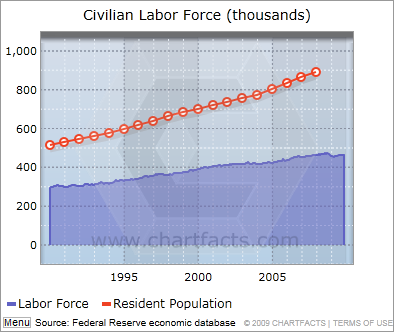
Data represents January 1990 to November 2009
The major industries of Mecklenburg County are banking, manufacturing, and professional services, especially those supporting banking and medicine. Mecklenburg County is home to six Fortune 500 companies,[17] including 21st-ranked Bank of America.
| Name | Industry | Revenue | Rank | |
|---|---|---|---|---|
| Bank of America | Banking | $100.1 billion | 21[18] | |
| Duke Energy | Utilities | $19.6 billion | 145[19] | |
| Nucor | Metals | $19.4 billion | 146[20] | |
| Family Dollar | Retail | $9.3 billion | 287[21] | |
| Sonic Automotive | Automotive retailing | $8.5 billion | 307[22] | |
| SPX | Electronics | $5.9 billion | 431[23] |
Wachovia, a former Fortune 500 company, had its headquarters in Charlotte until it was acquired by Wells Fargo for $15.1 billion. Wells Fargo maintains the majority of the former company's operations in Charlotte. The Federal Reserve approved the merger on October 12, 2008.[24]
Goodrich Corporation, a former Fortune 500 company, had its headquarters in Charlotte until it was acquired by United Technologies Corporation for $18.4 billion. Charlotte is now the headquarters for UTC Aerospace Systems.[25]
| Name | Industry | Number of employees |
|---|---|---|
| Health Care and Social Assistance | 35,700 |
| Educational Services | 18,495 |
| Finance and Insurance | 15,000 | |
| Transportation and Warehousing | 11,000 | |
| Retail Trade | 8,239 |
| Utilities | 7,900 |
| Public Administration | 6,800 |
| Public Administration | 5,512 |
| Arts, Entertainment and Recreation | 4,436 |
| Arts, Entertainment and Recreation | 4,100 |
| Educational Services | 4,000 |
| Transportation and Warehousing | 4,000 | |
| Finance and Insurance | 4,000 |
| Finance and Insurance | 2,850 |
| Educational Services | 2,700 |
| Retail Trade | 2,300 |
| Transportation and Warehousing | 2,175 |
| Professional Services | 2,100 | |
| Administrative and Support Services | 2,000 |
| Finance and Insurance | 2,000 |
Education
School system
The Charlotte-Mecklenburg Schools (CMS) serves the entire county; however, the State of North Carolina also has approved a number of charter schools in Mecklenburg County (independently operated schools financed with tax dollars).
Colleges and universities
University of North Carolina at Charlotte
King's College
Queens University of Charlotte
Central Piedmont Community College
Johnson & Wales University
Johnson C. Smith University
Union Presbyterian Seminary (Charlotte campus)
Libraries
The Public Library of Charlotte and Mecklenburg County serves residents of Mecklenburg County. Library cards from any branch can be used at all 20 locations. The library has an extensive collection (over 1.5 million items) of reference and popular materials including DVDs, books on CD, best sellers, downloadable media, and books.
The Billy Graham Library contains the papers and memorabilia related to the career of the well-known 20th century evangelist, Billy Graham.
Transportation
Air
The county's primary commercial aviation airport is Charlotte Douglas International Airport in Charlotte.
Intercity rail
With twenty-five freight trains a day, Mecklenburg is a freight railroad transportation center, largely due to its place on the NS main line between Washington and Atlanta and the large volumes of freight moving in and out of the county via truck.
Mecklenburg County is served daily by three Amtrak routes.
The Crescent train connects Charlotte with New York, Philadelphia, Baltimore, Washington, Charlottesville, and Greensboro to the north, and Atlanta, Birmingham and New Orleans to the south.
The Carolinian train connects Charlotte with New York, Philadelphia, Baltimore, Washington, Richmond, Raleigh, Durham and Greensboro.
The Piedmont train connects Charlotte with Raleigh, Durham and Greensboro.
The Amtrak station is located at 1914 North Tryon Street. A new centralized multimodal train station, Gateway Station, has been planned for the city. It is expected to house the future LYNX Purple Line, the new Greyhound bus station, and the Crescent line that passes through Uptown Charlotte.
Mecklenburg County is the proposed southern terminus for the initial segment of the Southeast High Speed Rail Corridor operating between Charlotte and Washington, D.C. Currently in conceptual design, the SEHSR would eventually run from Washington, D.C. to Macon, Georgia.
Light rail and mass transit
Light rail service in Mecklenburg County is provided by LYNX Rapid Transit Services. Currently a 9.6-mile (15.4 km) line running from Uptown to Pineville; build-out is expected to be complete by 2034.
Charlotte Area Transit System (CATS) bus service serves all of Mecklenburg County, including Charlotte, and the municipalities of Davidson, Huntersville, Cornelius, Matthews, Pineville, and Mint Hill.
The vintage Charlotte Trolley also operates in partnership with CATS. On July 14, 2015, the Goldrush Streetcar was revived to operate in Uptown after several decades of absence. The line runs from Trade Street, near Charlotte Transportation and Convention Center, to Elizabeth Avenue. In addition to several restaurants, this line also serves Central Piedmont Community College and Novant Health Presbyterian Hospital. The city is applying for a $50,000,000 Federal Transportation Grant, to gain funding to construct expansion of a line to serve Johnson C. Smith University to the West and East along Central Avenue.
Freight
Mecklenburg's manufacturing base, its central location on the Eastern Seaboard, and the intersection of two major interstates in the county have made it a hub for the trucking industry.
Major roadways
I-77
I-85
I-277
I-485
US 21
US 29
US 74
US 521
[[INLINE_IMAGE|//upload.wikimedia.org/wikipedia/commons/thumb/0/02/Charlotte_Route_4_shield.svg/20px-Charlotte_Route_4_shield.svg.png|//upload.wikimedia.org/wikipedia/commons/thumb/0/02/Charlotte_Route_4_shield.svg/30px-Charlotte_Route_4_shield.svg.png 1.5x, //upload.wikimedia.org/wikipedia/commons/thumb/0/02/Charlotte_Route_4_shield.svg/40px-Charlotte_Route_4_shield.svg.png 2x|Charlotte Route 4 shield.svg|h20|w20]] Route 4
NC 16
NC 24
NC 27
NC 49
NC 51
NC 73
NC 115
NC 160
NC 218
Arts and culture
Museums and libraries
Bechtler Museum of Modern Art
Billy Graham Library
Carolinas Aviation Museum
Charlotte Museum of History
Charlotte Nature Museum
Discovery Place
Discovery Place KIDS-Huntersville
Harvey B. Gantt Center for African-American Arts + Culture
ImaginOn
Levine Museum of the New South
McColl Center for Visual Art
Mint Museum Randolph
Mint Museum UPTOWN
NASCAR Hall of Fame
Public Library of Charlotte and Mecklenburg County
Sports and entertainment
Carolina Panthers
Charlotte Hornets
Charlotte Independence
Charlotte Hounds
Charlotte Checkers
Charlotte Knights
Charlotte Motor Speedway
Bank of America Stadium
Knights Stadium
American Legion Memorial Stadium
Music and performing arts venues
Actor’s Theatre of Charlotte
Bojangles' Coliseum
Carolina Actors Studio Theatre
ImaginOn
Knight Theater
The Neighborhood Theatre in NoDa
North Carolina Blumenthal Performing Arts Center
Ovens Auditorium
Spectrum Center (arena)
Spirit Square
Theatre Charlotte
Uptown Amphitheatre At the NC Music Factory
Verizon Wireless Amphitheatre Charlotte
Amusement parks
Carowinds
Great Wolf Lodge
Ray's Splash Planet
Other attractions
Carolina Place Mall
Carolina Raptor Center [45]
Concord Mills Mall in Cabarrus County
Lake Norman
Lake Wylie
Latta Plantation Nature Preserve [46]
Little Sugar Creek Greenway
Mecklenburg County Aquatic Center [47]
Northlake Mall
President James K. Polk Historic Site
Ray's Splash Planet [48]
SouthPark Mall
U.S. National Whitewater Center
Communities
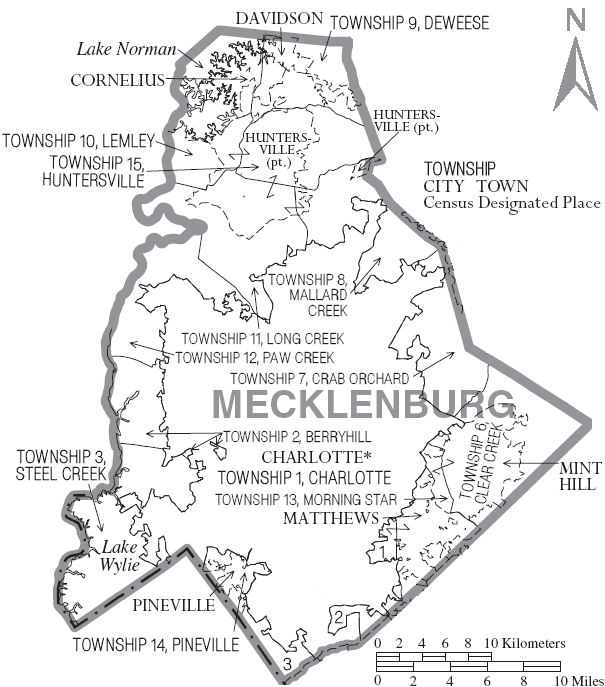
Map of Mecklenburg County, North Carolina With Municipal and Township Labels
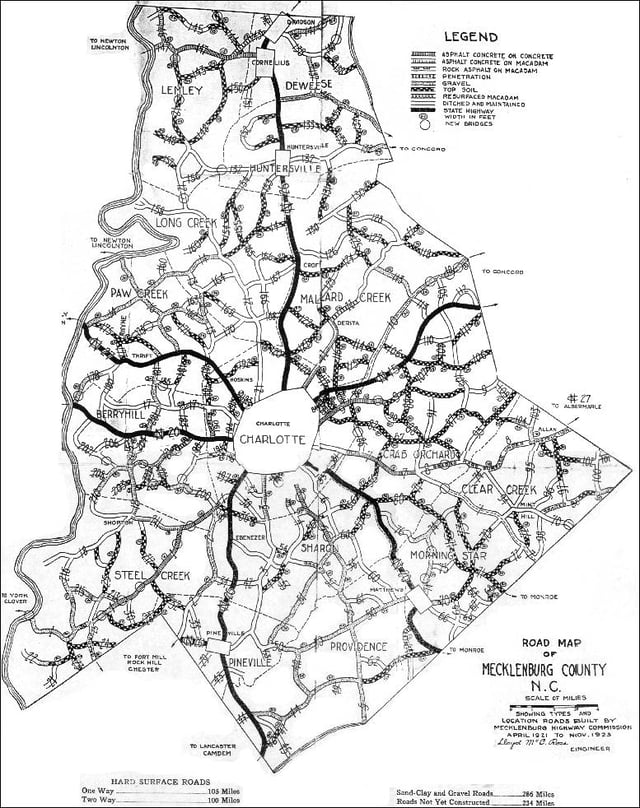
1923 Map of Mecklenburg County, North Carolina showing original Township boundaries
Mecklenburg County contains seven municipalities including the City of Charlotte and the towns of Cornelius, Davidson, and Huntersville (north of Charlotte); and the towns of Matthews, Mint Hill, and Pineville (south and southeast of Charlotte). Small portions of Stallings and Weddington are also in Mecklenburg County, though most of those towns are in Union County. Extraterritorial jurisdictions within the county are annexed by municipalities as soon as they reach sufficient concentrations.
City
Charlotte (county seat)
Towns
Cornelius
Davidson
Huntersville
Matthews
Mint Hill
Pineville
Stallings
Weddington
Unincorporated communities
Caldwell
Hopewell
Mountain Island
Prosperity Village Area
Townships
Berryhill
Charlotte
Clear Creek
Crab Orchard
Deweese
Huntersville
Lemley
Long Creek
Mallard Creek
Morning Star
Paw Creek
Pineville
Providence
Sharon (extinct)
Steele Creek
Notable people
Abraham Alexander (1717–1786), on the commission to establish town of Charlotte, North Carolina, North Carolina state legislator[27]
Evan Shelby Alexander (1767–1809), born in Mecklenburg County, later United States Congressman from North Carolina[27]
Nathaniel Alexander (1756–1808), born in Mecklenburg County, United States Congressman and governor of North Carolina[27]
Daniel Harvey Hill (1821-1889), Confederate General during the American Civil War and a Southern scholar.
Romare Bearden (1911-1988), 20th century African-American artist[28]
Brigadier General William Lee Davidson (1746-1781), was a North Carolina militia general during the American Revolutionary War.
Ric Flair (born 1949), retired professional wrestler
Anthony Foxx (born 1971), former United States Secretary of Transportation, former mayor of Charlotte.
Billy Graham (1918-2018), world-famous evangelist
Eliza Ann Grier (1864–1902), born in Mecklenburg County, first African-American female physician in Georgia
Anthony Hamilton (born 1971), American R&B/soul singer
Gen. Robert Irwin (North Carolina State Senator) (1738-1800), a distinguished commander of Patriot (American Revolution) militia forces, who is said to have been a signer of the Mecklenburg Declaration of Independence
Pat McCrory (born 1956), former Governor of North Carolina, former seven-term Mayor of Charlotte.
James K. Polk (1795–1849), 11th President of the United States. Polk was born in Mecklenburg County in 1795; his family moved to Tennessee when he was an adolescent.
Colonel William Polk (1758–1834) banker, educational administrator, political leader, renowned Continental officer in the War for American Independence, and survivor of the 1777/1778 encampment at Valley Forge.
See also
National Register of Historic Places listings in Mecklenburg County, North Carolina
